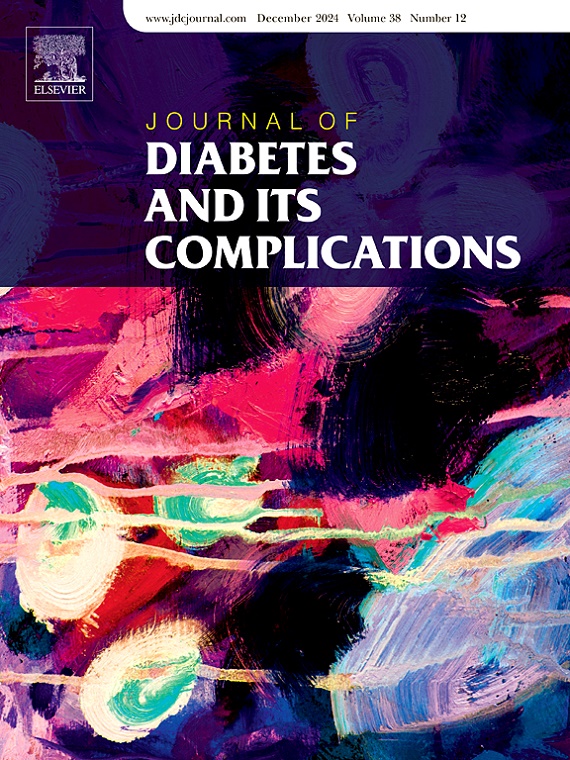普瑞巴林、加巴喷丁和度洛西汀治疗糖尿病周围神经病变疗效的回顾性比较分析
IF 3.1
3区 医学
Q3 ENDOCRINOLOGY & METABOLISM
引用次数: 0
摘要
本研究旨在比较普瑞巴林、加巴喷丁和度洛西汀对糖尿病周围神经病变(DPN)的影响,以指导量身定制的治疗。材料与方法在本回顾性研究中,180例2型糖尿病和DPN患者根据HbA1c和年龄按1:1:1进行三组匹配,每组60例患者。收集临床数据,并使用painDETECT评分来评估6周内的治疗反应。结果6周后,加巴喷丁组疼痛评分明显高于普瑞巴林组(P = 0.002)和度洛西汀组(P <;0.001)。普瑞巴林组得分高于度洛西汀组,但差异无统计学意义(P = 0.62)。度洛西汀的副作用发生率(23.3%)高于加巴喷丁(1.7%)和普瑞巴林(6.7%)(P = 0.001)。在改善超过50%的患者中,加巴喷丁组的平均HbA1c水平为9.42,普瑞巴林组为10.43,度洛西汀组为7.72。与加巴喷丁(P = 0.001)和普瑞巴林(P = 0.001)相比,度洛西汀显著降低HbA1c,而加巴喷丁和普瑞巴林之间无显著差异(P = 0.45)。结论度洛西汀联合普瑞巴林治疗DPN有效。加巴喷丁和普瑞巴林适用于HbA1c大于8.7的患者,而度洛西汀更适合HbA1c控制良好的患者。治疗应考虑副作用、依从性、费用和反应时间。证据水平:III级回顾性队列研究。本文章由计算机程序翻译,如有差异,请以英文原文为准。
Comparative analysis of the therapeutic effects of pregabalin, gabapentin, and duloxetine in diabetic peripheral neuropathy: A retrospective study
Introduction
This study aimed to compare the effects of pregabalin, gabapentin, and duloxetine on diabetic peripheral neuropathy (DPN) to guide tailored treatment.
Materials and methods
In this retrospective study, 180 patients with type 2 diabetes and DPN were matched 1:1:1 across three groups based on HbA1c and age, resulting in 60 patients per group. Clinical data were collected, and the painDETECT score was used to evaluate treatment response over six weeks.
Results
After six weeks, the gabapentin group had significantly higher pain scores than the pregabalin (P = 0.002) and duloxetine groups (P < 0.001). The pregabalin group's scores were higher than the duloxetine group's, but not significantly (P = 0.62). Side effects were more frequent with duloxetine (23.3 %) compared to gabapentin (1.7 %) and pregabalin (6.7 %) (P = 0.001). Among those with over 50 % improvement, mean HbA1c levels were 9.42 for gabapentin, 10.43 for pregabalin, and 7.72 for duloxetine. Duloxetine significantly lowered HbA1c compared to gabapentin (P = 0.001) and pregabalin (P = 0.001), with no significant difference between gabapentin and pregabalin (P = 0.45).
Conclusion
Duloxetine and pregabalin effectively treat DPN. Gabapentin and pregabalin are suitable for patients with HbA1c over 8.7, while duloxetine is better for those with well-controlled HbA1c. Treatment should consider side effects, adherence, costs, and response time.
Level of the evidence
Level III retrospective cohort study.
求助全文
通过发布文献求助,成功后即可免费获取论文全文。
去求助
来源期刊

Journal of diabetes and its complications
医学-内分泌学与代谢
CiteScore
5.90
自引率
3.30%
发文量
153
审稿时长
16 days
期刊介绍:
Journal of Diabetes and Its Complications (JDC) is a journal for health care practitioners and researchers, that publishes original research about the pathogenesis, diagnosis and management of diabetes mellitus and its complications. JDC also publishes articles on physiological and molecular aspects of glucose homeostasis.
The primary purpose of JDC is to act as a source of information usable by diabetes practitioners and researchers to increase their knowledge about mechanisms of diabetes and complications development, and promote better management of people with diabetes who are at risk for those complications.
Manuscripts submitted to JDC can report any aspect of basic, translational or clinical research as well as epidemiology. Topics can range broadly from early prediabetes to late-stage complicated diabetes. Topics relevant to basic/translational reports include pancreatic islet dysfunction and insulin resistance, altered adipose tissue function in diabetes, altered neuronal control of glucose homeostasis and mechanisms of drug action. Topics relevant to diabetic complications include diabetic retinopathy, neuropathy and nephropathy; peripheral vascular disease and coronary heart disease; gastrointestinal disorders, renal failure and impotence; and hypertension and hyperlipidemia.
 求助内容:
求助内容: 应助结果提醒方式:
应助结果提醒方式:


